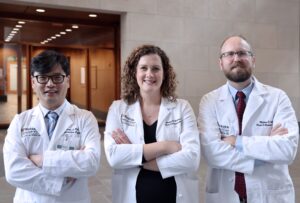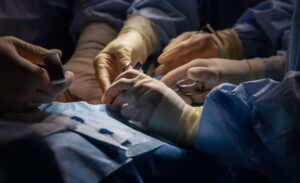Pediatric Facial Paralysis
A child’s ability to use facial expression to communicate is an important part of his or her social development. When facial paralysis occurs, caused by a variety of factors, such as at birth or by injury or illness, it can make those expressions difficult or impossible, leading to functional problems and psychosocial implications.
Our team of pediatric specialists is experienced in working with families who have a child with facial paralysis, and we understand the unique difficulties that can come with this condition. Any treatment plan we offer is based in compassionate care, a thorough understanding of the condition and ongoing communication with the parents and family involved.
Overview
Lack of nerve and muscle function in the face is known as facial palsy, or facial paralysis. There are more than a hundred known causes of facial paralysis, and it can occur in anyone, regardless of cause, duration or age. In children, paralysis is most likely to occur from congenital causes, birth-related trauma or other injuries.
Congenital Facial Paralysis
Congenital facial paralysis can occur on one side of the face, called unilateral paralysis, or both sides of the face, called bilateral paralysis. Unilateral paralysis can be related to a number of conditions, including hemifacial microsomia, in which one half of the face does not fully develop in the womb. A hemifacial microsomia condition called Goldenhar syndrome also can affect the eyes and spine.
Möbius syndrome is one type of congenital facial paralysis that can affect one or both sides of the face. The exact cause of Möbius syndrome is not known, but it is thought to occur when the blood vessels that nourish the facial muscles and nerves do not develop. This condition causes paralysis of one of the eye muscles, meaning kids cannot look laterally (left to right). Other nerves also may be involved, including those responsible for gag reflex and tongue movement. Möbius syndrome is sometimes associated with Poland syndrome, a congenital condition that affects the chest and hands.
Acquired Facial Paralysis
In some cases, babies may sustain an injury to the facial nerve during birth. Most often, this injury is minor and temporary, and resolves within several months after birth. In other cases, the paralysis can persist, resulting in a difference in movement between the two sides of the face. In certain cases, surgery may help improve facial motion for children with this kind of paralysis.
Other forms of trauma also can produce facial paralysis in children, including head injury and concussion, and cuts that divide the facial nerve and may damage the muscles that produce expression. In some children, the center in the brain that produces facial motion is injured during removal of tumors, such as an acoustic neuroma, ependymoma or medulloblastoma. In many children with congenital facial paralysis, we are unable to determine the actual cause of the condition.
Treatment of Facial Paralysis in Children
Babies with facial paralysis may have difficulty eating because the muscles required to suck are affected. Our team of specialized pediatric surgeons use a variety of techniques—many borrowed from their experience treating babies with cleft palate—to help infants with facial paralysis. If you have an infant with facial paralysis, you may find it helpful to read information about feeding an infant with cleft lip and palate. Our team of specialists also consider the health of your child’s eyes, since their eyes may not close completely. We follow speech development and nutrition closely. Our team also offers treatments that can improve the ability to smile. We are here to fully support your child throughout growth and development.
Unilateral Facial Paralysis Surgery
When a child has unilateral facial paralysis, we may use a technique called cross-facial nerve grafting. In this procedure, a nerve graft that acts like an extension cord is removed from the patient’s leg, which typically results in a small, numb patch on the upper, outer part of the foot, a condition that does not tend to cause ongoing problems. That nerve is grafted into the unaffected side of the face to borrow from the working nerves; after nine to 12 months, a donor muscle is then transplanted from the patient’s leg into the face and connected to the previously placed nerve to create a smile motion. This procedure requires that the muscle be precisely positioned to achieve the best results.
The first signs of facial motion usually begin several months after surgery. Although we cannot restore the ability to make the full range of facial expressions, we can provide options to help with smile. We use techniques borrowed from facelift procedures to minimize scarring on the face.
Bilateral Facial Paralysis Surgery
When a child has bilateral facial paralysis, the option to connect nerves from one side of the face to the other is not available because both sides of the face are affected. Instead, we can bring in new muscle and repurpose a nerve that assists with chewing. Borrowing this nerve does not affect chewing. Three months after the first surgery, enough healing has occurred to allow us to perform the same procedure on the other side of the face. We use a facelift-type incision, which runs in front of the ear. This incision tends to heal very well, leaving a thin, flat scar.


